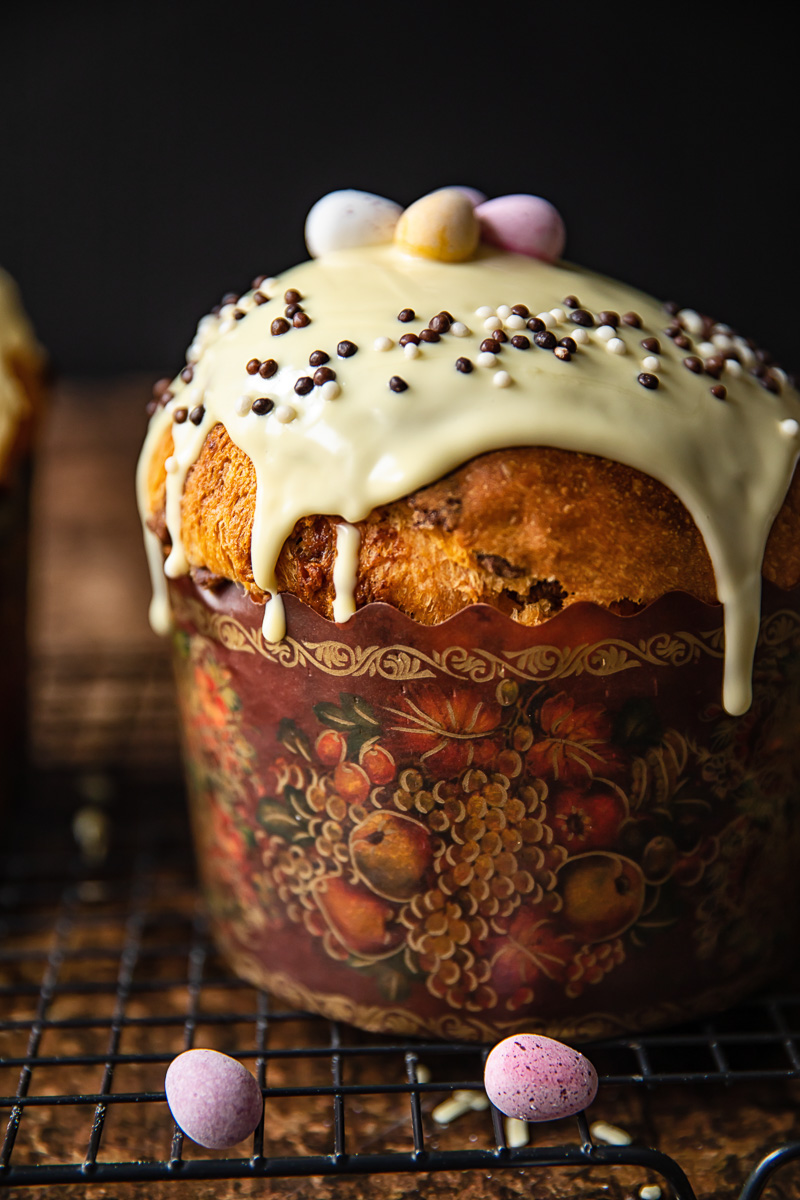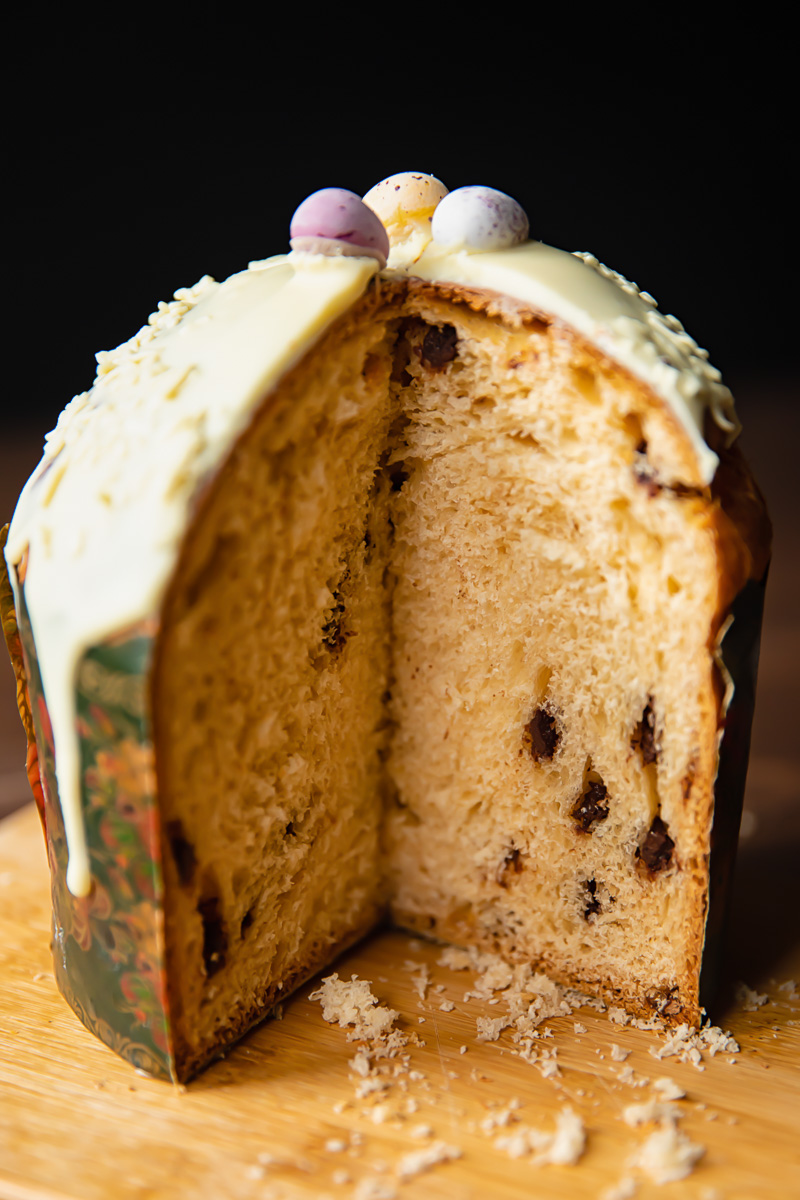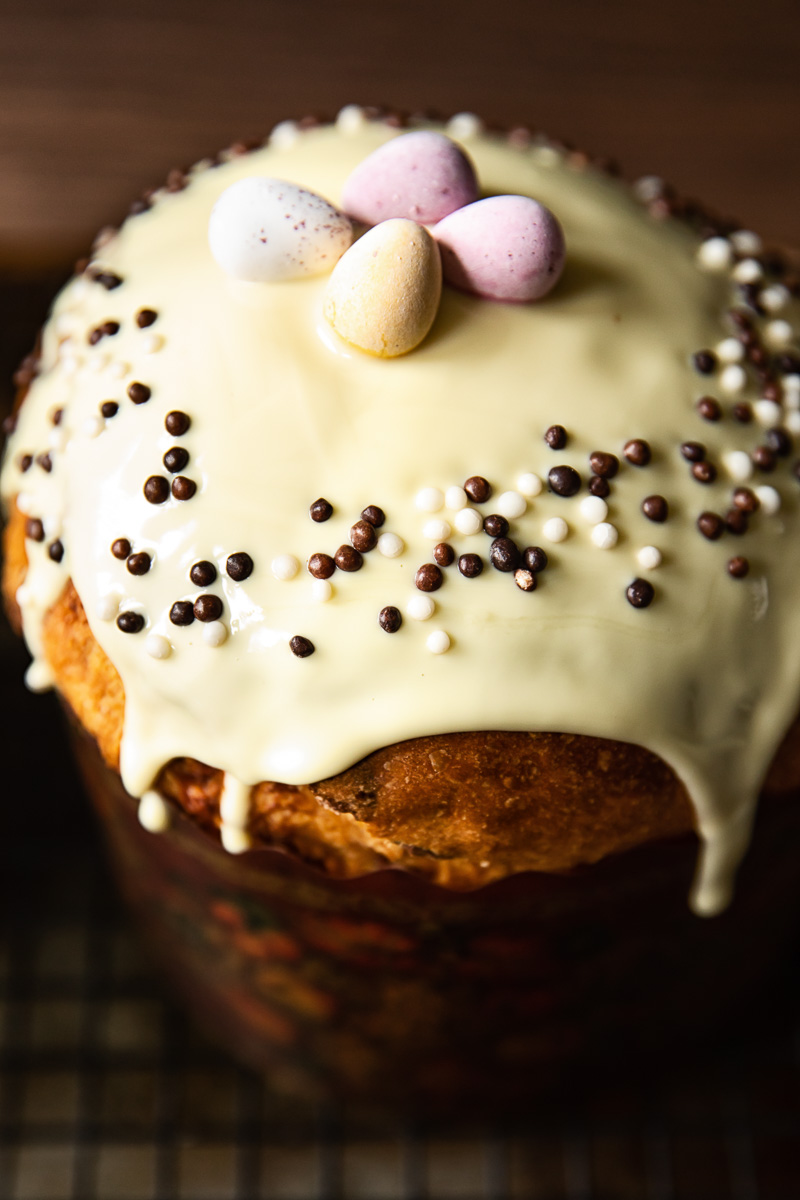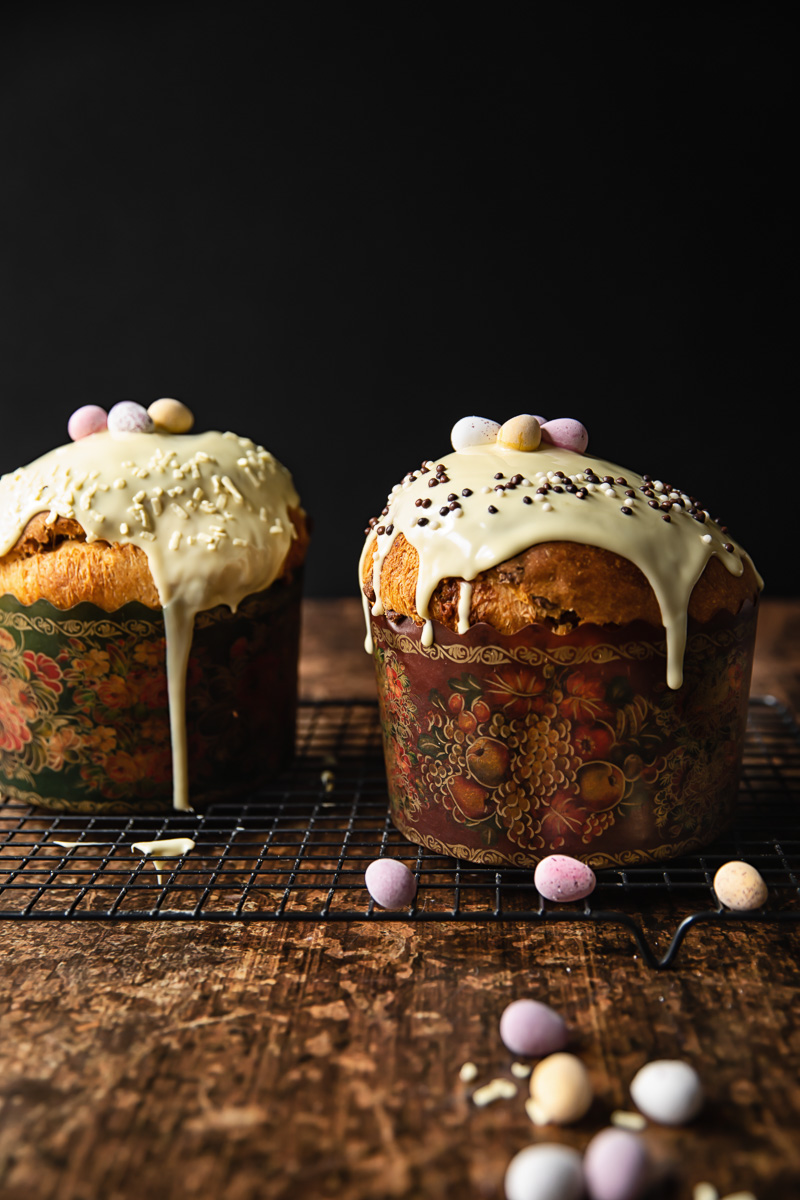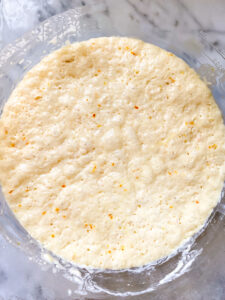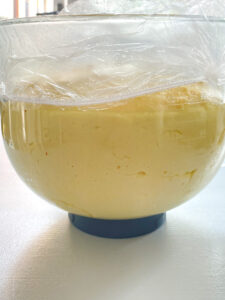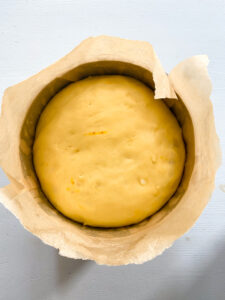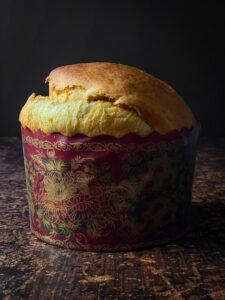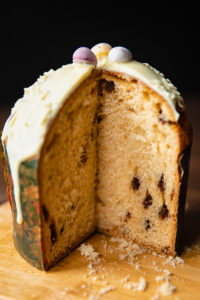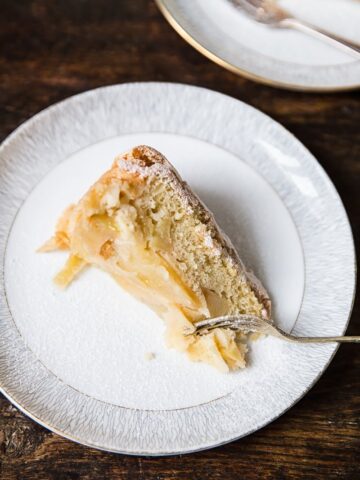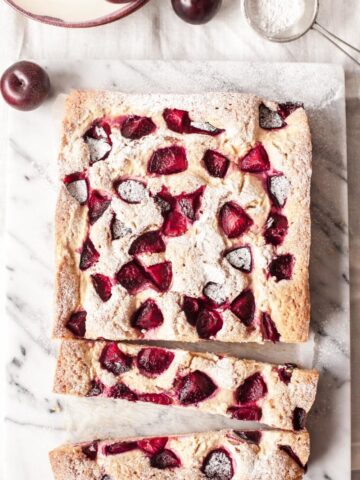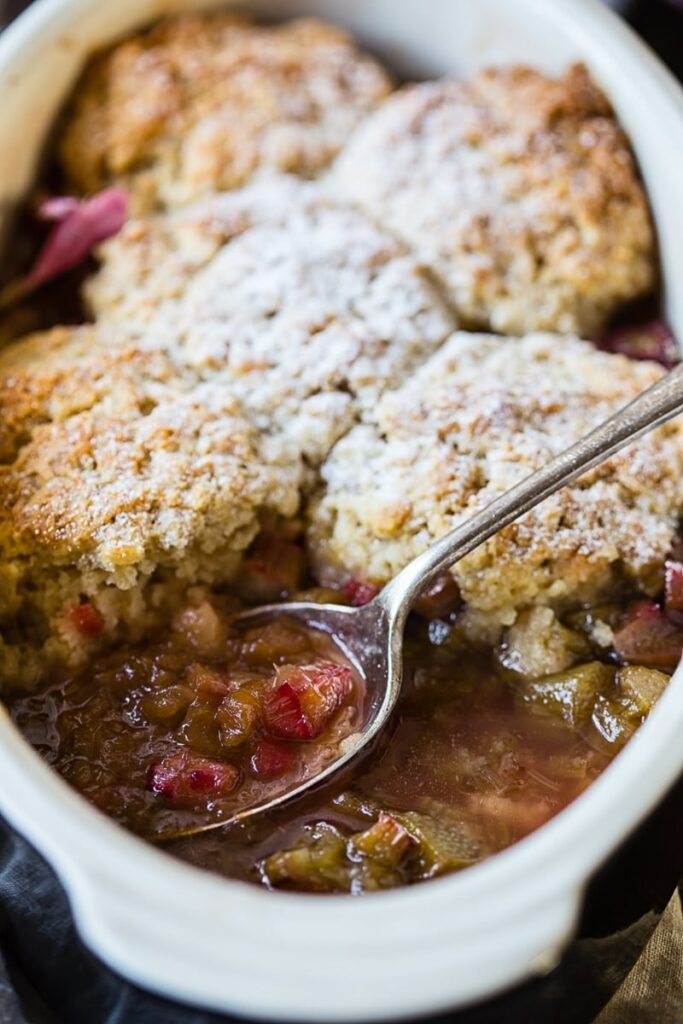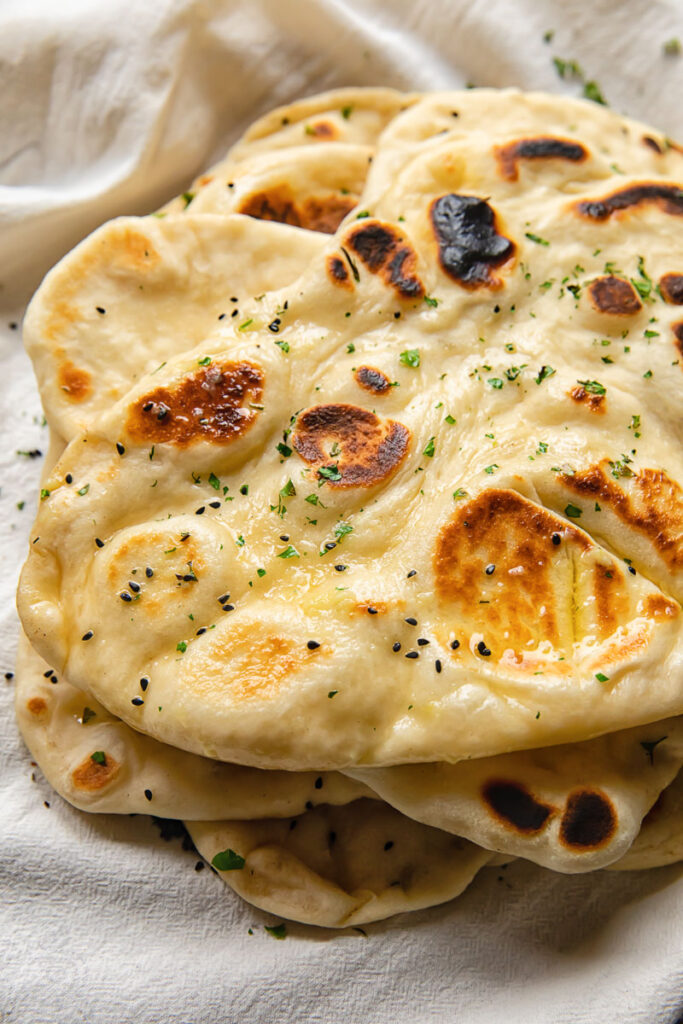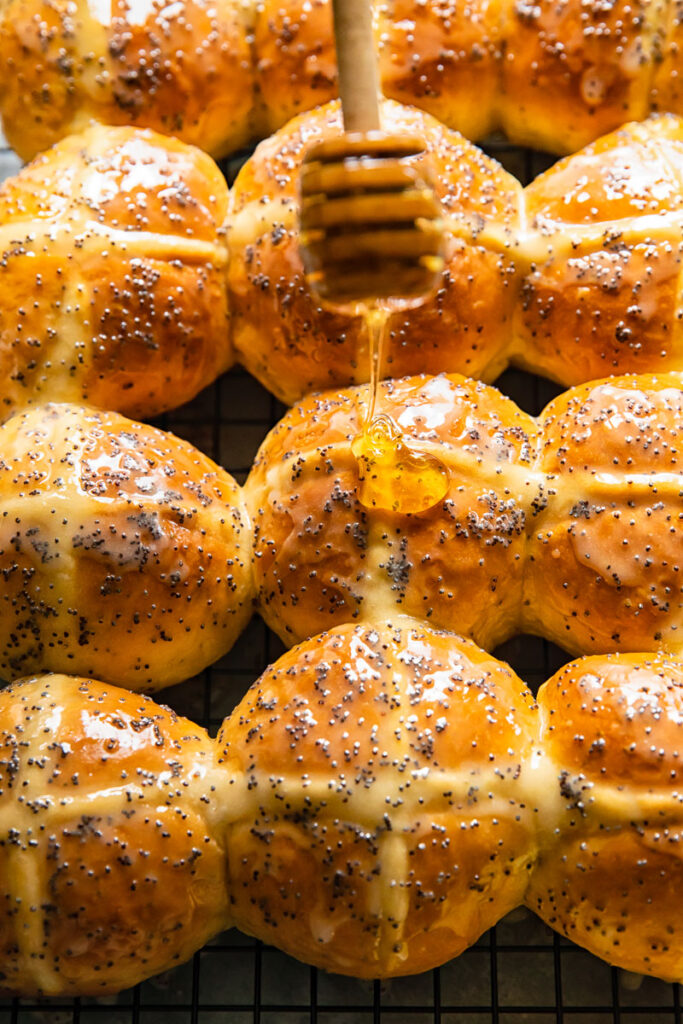This brioche like sweet Easter bread, glazed with a simple sugar icing or melted white chocolate, aka Kulich or Paska in Russian and Ukrainian, is always the biggest hit at holiday brunches!
Try this Kulich recipe with another Russian Easter favourite Sweet Cheese Pudding Paskha.
I feel an incredible pull of tradition every year when Easter comes around. No matter how busy I am, the need to cook, bake and colour eggs overpowers everything else.
I’ve written about Easter tradition of egg colouring. And if you’ve been following me for a while, you know that Easter is the biggest holiday in the Orthodox tradition, which is influential across Eastern Europe, whether people are Orthodox or not. Everyone celebrates Easter.
What is Russian Easter bread?
It’s called Kulich and also Paska. It is a sweet bread, that is ubiquitous in Russian and Ukrainian households around Easter. It’s an unbreakable tradition, like hot cross buns in other parts of the world.
Its sweet, rich and buttery yellow-coloured flesh studded with all kinds of great things like golden raisins, candied citrus peel, almonds. It’s what I want to stuff my face all the time.
If I were to compare it to anything I would say it’s a cross between Italian Panettone and French Brioche. It has the same light and fluffy texture with a wonderful amount of sweetness.
How to make it
My grandma would start the dough the night before, let it rise overnight and wake up well before dawn to make all kinds of goodies. Sweet and savoury filled pastries, cinnamon buns and Kulich.
Waking up to the sweet aroma of freshly baked bread is one of my favourite childhood memories. And I hope to pass them onto my children.
My grannie’s baking was the best, none of my friends’ grandmothers came even close to her greatness. Unfortunately, she never wrote down any recipes, and some of the most traditional recipes, which she was the keeper of, got lost with her passing.
Because of such high expectations, only heightened by my nostalgic memories, I never thought I would like another Kulich. However, I wanted to revive the tradition in my own family, so I went on a recipe hunt.
I spent a while searching in hopes to find one that resembled my grandma’s. Truth is, I was only a child and didn’t remember how grandma made the bread.
But I’ve managed to develop my rendition of the recipe. I’ve lost count how many Kuliches I baked to strike the perfect balance of a sweet and tender flesh, which also has enough structure to rise tall and proud.This recipe took me years to develop. It may not be exactly the same as my grandma’s, but it’s close!
I did add a few twists of my own. Firstly, I used chocolate chips instead of the traditional raisins and I topped it with melted white chocolate instead of sugar glaze. I also included saffron according to 19th century baking traditions.
If you make bread or cinnamon rolls, making this Easter bread recipe will not be too different for you. It takes a whole day because it consists to 3 stages. Nonetheless, none of them are time consuming or difficult.
What pan to use for Kulich
Kulich is baked to be a very tall bread, so large coffee cans are often used in Russia to create that traditional shape. However, I bake mine in a deep 8 inch cake pan or specially made moulds.
You can also order special pans and moulds, that are made for the Italian Panettone to bake yours. I got mine on Amazon.
Decorating tips
Traditionally Kulich is covered with a simple sugar glaze made with a mix of icing sugar and water. My grandmother poured a combination of beaten egg white and sugar, which hardened and turned glossy.
I personally prefer using melted white chocolate to top my Easter bread. Sometimes I like to keep it unglazed and pipe the traditional Orthodox lettering on it.
XB, are the initials, which stands for Christ is Risen in Russian. It’s the phrase you will hear people say to each other all day long. Powerful words that replace ‘hello’ for the day!
Usually our first loaf disappears within a couple of hours. Thank God the recipe makes 3! That means you can indulge before the day knowing that your Easter table will be crowned with this gorgeous bread, that’s been enjoyed by generations of others before us.
Happy Easter!
Recipe tips and notes
- When starting on this recipe make sure to read the instructions all the way through to fully understand what ingredients and equipment are required.
- The classic shape of this bread is narrow and tall. I mean it’s even taller than Italian Panettone. Large coffee cans were used by older generations. However, you can successfully use panettone moulds, available online. You can also search for Paska or Kulich moulds on Amazon if you want them beautifully decorated like mine.
- I’ve also successfully used a regular pan with high sides for my Kulich. I don’t want you to be put off by the speciality moulds. They are pretty but not essential.
- I use saffron in my recipe as it’s been historically used in baking Kulich. It gives the bread a beautiful golden colour. While it’s traditional, saffron is expensive and not many use it nowadays, so you can safely omit it in your version.
- Correct proofing of the dough is essential to this recipe as with all yeasted bakes. I gave you approximate timing for each stage but they are largely dependent on the temperature of your house. It might take less or more time, so my advice to you is to watch your dough. If it hasn’t reached the desired volume after rising for a certain amount of time, keep at it. Visual cues are what is important. I included step by step photos in the recipe card to be your guide.
- I decorate my Kulich with a white chocolate glaze or a simple sugar glaze or leave it completely bare. It all depends on what I’m in the mood for! It’ll be great either way, although chocolate icing does make it a bit more spectacular!
- I tend to add chocolate chips into my Easter bread because they are the popular choice for my family. But raisins and dried fruit are more traditional, so feel free to substitute. If you do use raising, soak them first, otherwise they will absorb moisture from the dough and will make it dry. Traditionally they are soaked in rum.
Storage and leftovers
This recipe makes two loaves, so you’ll have plenty for the next couple of days. Store what you can’t eat immediately in a bread box or plastic bag.
It will remain fresh at room temperature for two days, or up to a week if refrigerated. But the earlier you eat it the better it will be, so indulge!
More Easter recipes
- Double Decker Devilled Eggs
- Roast Leg of Lamb with Mint Sauce
- Glazed Ham
- Rosemary Potatoes au Gratin
- Tsoureki Greek Easter Bread
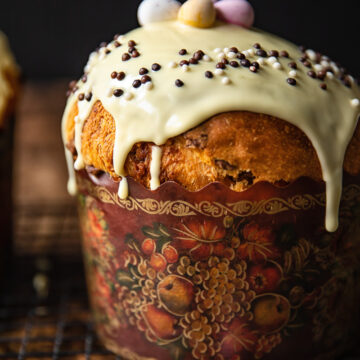
Russian Easter Bread Kulich
Ingredients
For the bread
- 500g/4 ½ cups strong bread flour
- 125 ml/ ½ cup whole milk
- pinch saffron threads
- 14 g/ 2 tbsp active dry yeast
- 150g/ ¾ cup granulated sugar
- 150g/ ½ cup + 2 tbsp unsalted butter
- 2 egg yolks
- 2 eggs
- 4 tsp vanilla
- ¼ tsp salt
- 100g/1/2 cup chocolate chips milk or white
For the glaze
- 100g/3.5 oz white chocolate melted
- 1 tbsp sprinkles
Instructions
- To a small saucepan add the milk with a pinch of saffron and warm up lightly without bringing it to a boil. Alternatively, you can warm up the milk in a microwave. In the bowl of a stand mixer, fitted with a paddle attachment, combine the infused milk with the yeast, 50g/¼ cup of the sugar and 100g/3/4 cup of the flour, cover it with plastic wrap and let it rise in a warm place for 1 hour.
- With an electric mixer whip the softened butter with the remaining sugar until creamy, then add the eggs, egg yolks, vanilla and the salt. Then add this mixture to the yeast mixture and mix until well combined.
- Replace the paddle attachment with a dough hook, add the remaining 400g/3 ¾ cups flour and start kneading until you get elastic dough. This will take 10-15 minutes on medium speed. Towards the end of the kneading time turn the speed up to high and knead for 5 minutes to develop gluten in the dough. At the end the dough will be very soft and a little sticky. Fold in chocolate chips until evenly distributed.
- Transfer the dough to an oiled bowl, cover with plastic wrap and let it rise in a warm place for 2 hours-2.5 hours until it’s doubled in bulk. It might take longer if your house is cool.
- Divide the dough and with oiled hands transfer into two 5 inch or 6 inch pans. Ideally you pans should also be tall or you can use panettone moulds. You can build up the sides of your pan with parchment paper if your pans are not tall enough. Your dough should come up no higher than halfway up the sides of the pans. Let the dough rise one more time for 40 minutes to 1 hour.
- Bake in the preheated to 180C/350F for 35-40 minutes. Take out of the oven and let it cool, then remove from pans when cool enough to handle. Don't remove if using paper moulds.
- Cool and glaze with melted white chocolate and decorate sprinkles. The bread is best on the day it is baked or the following day.


